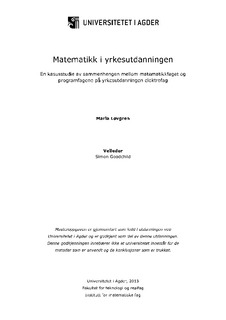| dc.contributor.author | Løvgren, Maria | |
| dc.date.accessioned | 2019-08-20T07:22:17Z | |
| dc.date.available | 2019-08-20T07:22:17Z | |
| dc.date.issued | 2013 | |
| dc.identifier.uri | http://hdl.handle.net/11250/2609246 | |
| dc.description | Masteroppgave matematikkdidaktikk MA502 – Universitetet i Agder 2013 | nb_NO |
| dc.description.abstract | The teaching of mathematics in vocational education programs in Norway is required to make
connections with each student's professional practice and daily life. The aim of this study is to
investigate the relationship between mathematics and the program subjects in electrical
vocational education. This is achieved through a description of the diverse teaching practices,
leading to where the two subjects overlap. My main question is: What characterizes the
relationship between mathematics 1T-Y and the program subjects in the electric vocational
education? To address this question, I have formulated three research questions:
1. What are the similarities and differences in the presentation of mathematics in the
mathematics teaching and the program subjects?
2. How do students and teachers experience the relationship between mathematics and
the program subjects?
3. In what way do mathematics and the program subjects accommodate each other?
I have used qualitative research methods in the form of interviews and observation. The data
collection involves interviews with six students from the same class, two vocational teachers,
two mathematics teachers and observation of the teaching. The analysis is based on sociocultural theory, literature of the transfer of knowledge and boundary crossing.
The study shows clear evidence that there is a link between the mathematics and the
vocational subjects. This is shown both in the interviews and the observations. The most
obvious connection is that both teaching practices contain much of the same mathematics.
The students learn the fundamental mathematics in the mathematics lessons, while the
program subjects are more focused on the practical application. Hence, mathematics is
characterized as a tool in the program subjects.
It is observed that the teaching practices resemble each other in terms of the way the lessons
are structured, the use of the same classroom, and there are some clear similarities in the way
the teachers communicate with the students. The students still experience that mathematics is
taught differently in the various subjects. This is especially because of emphasis on
thoroughness in the mathematics lessons, and that one of the teachers use more humour and
his own procedures in two of the vocational subjects.
The most sobering outcome of this study is the difficulty students have in making use of the
mathematics in the vocational subjects, despite the fact that the subjects have many
similarities. The mathematics used in the vocational subjects is far more advanced than the
mathematics the students are trained to use in mathematics classes. This was demonstrated
particularly in some graphs the students were presented with in two of the program subjects.
These were very complicated, and the mathematical operations and the underlying structures
were hidden from the students. Many students seemed to lose understanding when they were
challenged to use a right angle triangle to understand the connection between the power
efficiency of and motor and how Pythagoras rule could be used in this context.
The study presents few conclusions, but rather many new questions for further investigation. | nb_NO |
| dc.language.iso | nob | nb_NO |
| dc.publisher | Universitetet i Agder ; University of Agder | nb_NO |
| dc.rights | Attribution-NonCommercial-NoDerivatives 4.0 Internasjonal | * |
| dc.rights.uri | http://creativecommons.org/licenses/by-nc-nd/4.0/deed.no | * |
| dc.title | Matematikk i yrkesutdanningen : En kasusstudie av sammenhengen mellom matematikkfaget og programfagene på yrkesutdanningen elektrofag | nb_NO |
| dc.type | Master thesis | nb_NO |
| dc.subject.nsi | VDP::Samfunnsvitenskap: 200::Pedagogiske fag: 280::Fagdidaktikk: 283 | nb_NO |
| dc.source.pagenumber | 114 s. | nb_NO |

